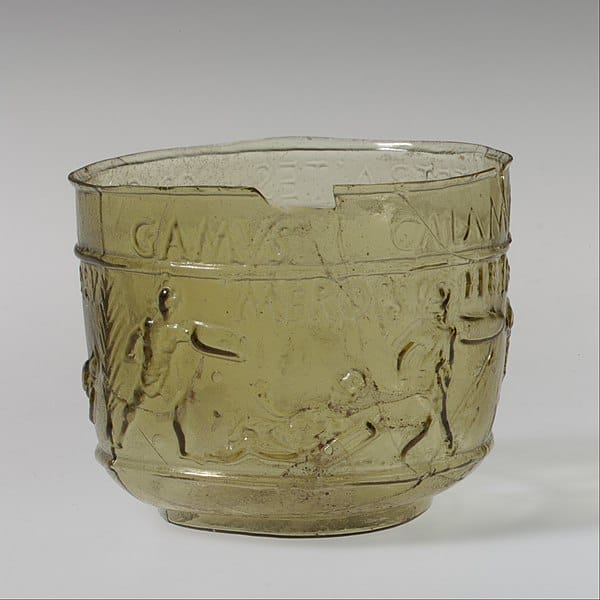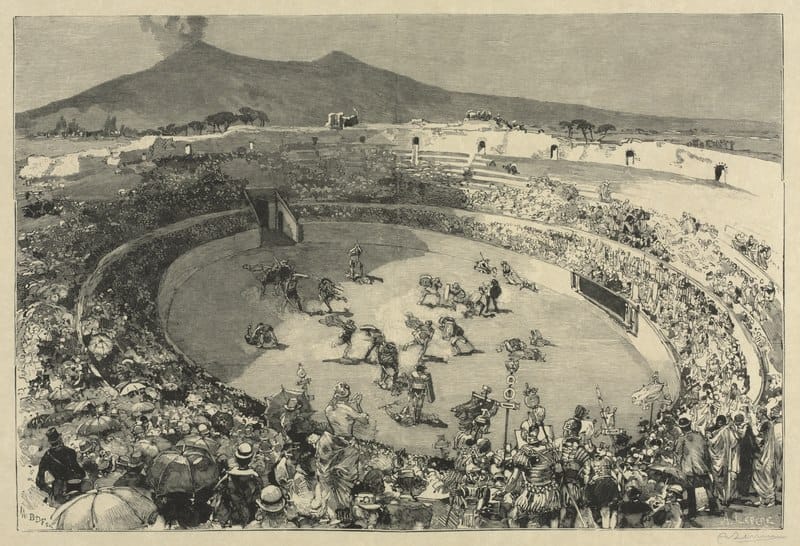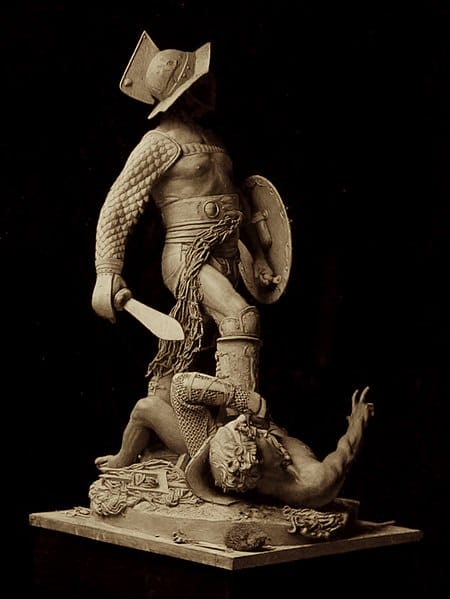Archaeologists have long been fascinated with the Roman Empire, particularly its gladiators and their weapons. One such finding, the glass gladiator cup, has recently gathered attention due to its mysterious origins and unique properties. Made from delicate glass, these cups were used by gladiators to drink wine before battle, but their true purpose remains shrouded in mystery.
Despite their fragility, these cups were highly prized by gladiators and other members of Roman society. Some believe that the glass was specially treated to make it stronger and more durable, while others speculate that the cups were imbued with magical properties that protected their owners in battle. Whatever their true purpose, the glass gladiator cups remain a fascinating artifact of ancient Rome that continues to captivate historians and archaeologists alike.
History of The Glass Gladiator Cup
The Glass Gladiator Cup is a prestigious award given to the winner of the annual gladiator games held in Rome. The cup has a rich history dating back to the early days of the Roman Empire. The cup was first introduced in 50 AD by Emperor Claudius, who wanted to honor the bravery and skill of the gladiators who fought in the arena. The cup was made of glass, which was a rare and expensive material at the time.
Over the years, the cup became a symbol of excellence and honor in the gladiator community. Gladiators would train for years in hopes of winning the cup and earning the respect of their peers. During the reign of Emperor Nero, the cup became even more prestigious. Nero was a huge fan of the gladiator games and would often attend the matches himself. He commissioned a new cup to be made, one that was even more ornate and elaborate than the original.
Design and Symbolism
The Glass Gladiator Cup is a masterpiece of craftsmanship and design. It is made of high-quality glass and was crafted by skilled artisans who paid attention to every detail. The cup is made of thick, clear glass that is exceptionally durable and has a smooth finish. The base of the cup is wide and sturdy, providing a solid foundation for the cup. The cup’s shape is elegant and symmetrical, with a wide opening at the top that narrows down to a smaller base.

The shape of the cup could be inspired by ancient Roman drinking vessels, such as the kylix (a shallow, wide-rimmed drinking cup) or the calyx krater (a large bowl with handles used for mixing wine and water). These shapes were commonly used for drinking during feasts and gatherings.
The Glass Gladiator Cup is not just a beautiful piece of glassware – it is also rich in symbolism and meaning. The cup is adorned with intricate designs and symbols that tell a story of power, strength, and victory. The cup’s most prominent feature is the gladiator helmet that sits atop the cup’s stem. The helmet is a symbol of strength, courage, and victory, and it represents the gladiators who fought in the arena.
The glass was indeed used in ancient Rome for various purposes, including vessels for drinking. A gladiator cup made of glass would showcase the skill of ancient glassmakers, with attention to details like clarity, color, and thickness of the glass. Intricate patterns or decorations could be etched or engraved onto the surface of the cup, depicting scenes of gladiatorial combat, Roman deities, or other symbolic imagery.
The cup’s stem is decorated with a series of intricate patterns and symbols that represent the gladiator’s journey to victory. The patterns are etched into the glass, creating a beautiful and delicate texture that adds to the cup’s overall beauty. The patterns include swords, shields, and other weapons that represent the gladiator’s strength and skill. The Glass Gladiator Cup is a masterpiece of design and symbolism. Its craftsmanship is exceptional, and its symbolism is rich and meaningful. It is a beautiful piece of glassware that tells a story of power, strength, and victory.
Mysteries and Legends
The history of the Glass Gladiator Cup is shrouded in mystery and legend. According to ancient Roman accounts, the cup was created by the gods and was used in gladiator battles as a prize for the victor. Some legends claim that the cup was made from a single piece of glass, while others suggest that it was crafted from a rare and magical material. Despite the lack of concrete evidence, many historians believe that the cup was indeed used in gladiator battles and was highly prized by both fighters and spectators alike. Some speculate that the cup may have even been imbued with mystical powers that granted the victor great strength and agility in battle.

In modern times, the Glass Gladiator Cup has become the subject of much speculation and debate. Some experts believe that the cup may actually be a fake, created in the 19th century to capitalize on the popularity of ancient Roman artifacts. Others argue that the cup is authentic but was likely created during the Renaissance as a tribute to the gladiatorial games of ancient Rome.
Ongoing debate aside, the Glass Gladiator Cup remains a fascinating and enigmatic artifact that continues to capture the imagination of historians and casual observers alike. Whether it is a genuine piece of ancient Roman history or a clever forgery, the cup’s mystique and allure are sure to endure for generations to come.
Cultural Impact and Legacy
The Glass Gladiator Cup has had a significant impact on the cultural heritage of ancient Rome. It was a symbol of power and prestige, and owning one was a status symbol for the wealthy elite. The cup was often used in gladiatorial games, where it was filled with wine and passed around to the spectators.
The cup’s legacy has extended beyond ancient Rome, as it has been featured in numerous works of art and literature throughout history. For example, the cup was prominently featured in the 1960 film “Spartacus,” which helped to popularize the cup among modern audiences. In addition to its cultural significance, the Glass Gladiator Cup has also had a lasting impact on the world of archaeology. Many of the surviving cups have been excavated from ancient Roman sites, providing valuable insights into the daily lives of ancient Romans.
Overall, the Glass Gladiator Cup remains an enduring symbol of ancient Rome’s cultural and historical legacy. Its influence can still be seen today in popular culture, art, and archaeology, making it a truly remarkable artifact of human history.

People Also Ask:
What is the glass gladiator cup about?
The scene around the cup depicts four pairs of gladiators fighting. Each man is identified by name in the Latin inscription above him. Some of the names match those of known gladiators who became famous in games held in Rome during the Julio-Claudian period, suggesting that such cups may have been made as souvenirs.
What was the purpose of the gladiator shows?
Roman gladiator games were an opportunity for emperors and rich aristocrats to display their wealth to the populace, commemorate military victories, mark visits from important officials, celebrate birthdays, or simply distract the populace from the political and economic problems of the day.
What happened in the gladiator games?
Usually, the fights were single-combat and lasted for 10-15 exhausting minutes; as many as 13 combats could take place over the course of a single busy day at the arena. The gladiators often dressed as barbarians, recalling the glorious victories of the Roman legions against them, and came in many different classes.
Were there female gladiators?
The gladiatrix is the female equivalent of the gladiator of ancient Rome. Like their male counterparts, gladiatrices fought each other, or wild animals, to entertain audiences at various games and festivals. Very little is known about them.
How many gladiators died in the Colosseum?
How many people died in the Colosseum? It is impossible to know with certainty, but it is believed that as many as 400,000, between gladiators, slaves, convicts, prisoners, and myriad other entertainers, perished in the Colosseum over the 350 or so years during which it was used for human bloodsports and spectacles.
Hello, my name is Vladimir, and I am a part of the Roman-empire writing team.
I am a historian, and history is an integral part of my life.
To be honest, while I was in school, I didn’t like history so how did I end up studying it? Well, for that, I have to thank history-based strategy PC games. Thank you so much, Europa Universalis IV, and thank you, Medieval Total War.
Since games made me fall in love with history, I completed bachelor studies at Filozofski Fakultet Niš, a part of the University of Niš. My bachelor’s thesis was about Julis Caesar. Soon, I completed my master’s studies at the same university.
For years now, I have been working as a teacher in a local elementary school, but my passion for writing isn’t fulfilled, so I decided to pursue that ambition online. There were a few gigs, but most of them were not history-related.
Then I stumbled upon roman-empire.com, and now I am a part of something bigger. No, I am not a part of the ancient Roman Empire but of a creative writing team where I have the freedom to write about whatever I want. Yes, even about Star Wars. Stay tuned for that.
Anyway, I am better at writing about Rome than writing about me. But if you would like to contact me for any reason, you can do it at contact@roman-empire.net. Except for negative reviews, of course. 😀
Kind regards,
Vladimir
